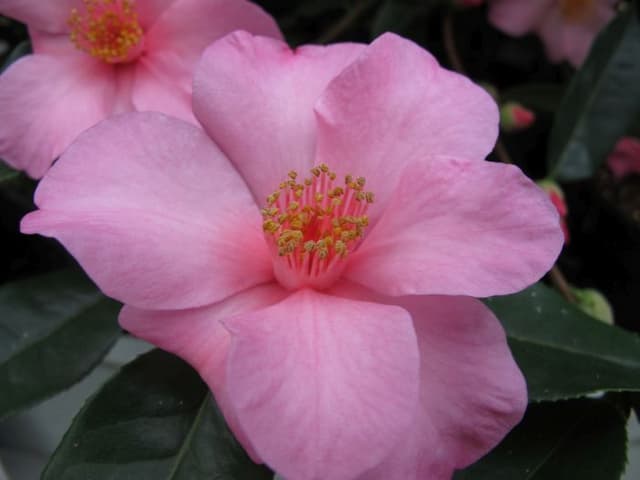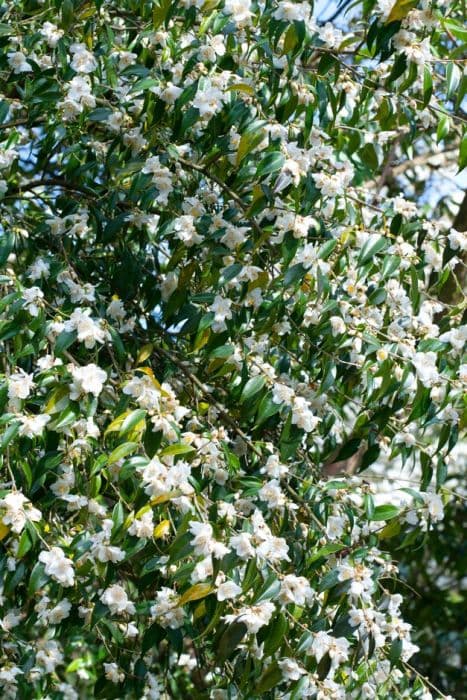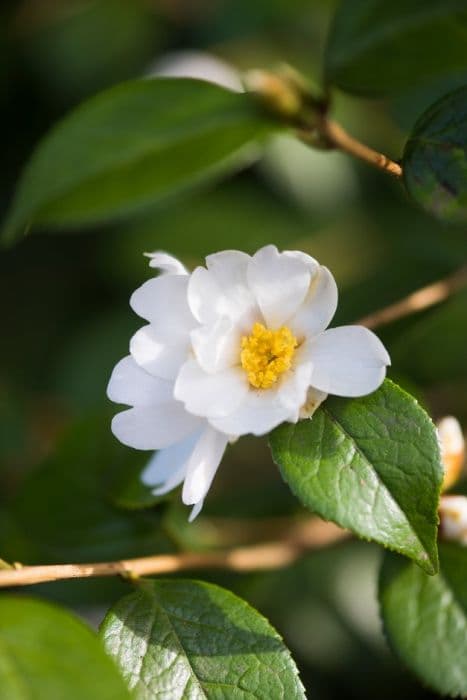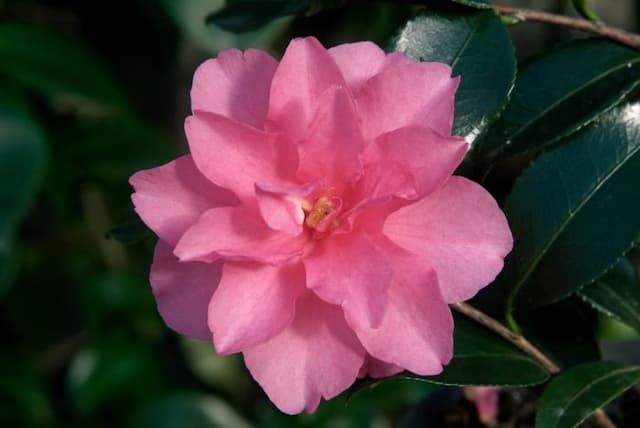Williamsii Camellia Camellia × williamsii 'Grand Jury'

ABOUT
The 'Grand Jury' is a type of camellia known for its attractive flowers and foliage. It has glossy, deep green leaves that provide a perfect backdrop for its showy blooms. The flowers themselves are large and peony-like in shape, often boasting a luxurious array of overlapping petals. They possess a soft to deep pink hue which can vary in intensity, sometimes featuring a gradient of color. These flowers are prominent and can really stand out in the landscape, especially during their blooming season when they adorn the evergreen bush. The camellia's growth habit is somewhat open, and it tends to produce a profusion of blossoms which can give the plant a very lush appearance. The overall aesthetic of the 'Grand Jury' camellia is one of elegance and can bring a splash of color to gardens or landscapes when many other plants are not in bloom.
About this plant
 Names
NamesFamily
Theaceae.
Synonyms
Williamsii Camellia, Jury's Yellow Camellia.
Common names
Camellia × williamsii 'Grand Jury'
 Toxicity
ToxicityTo humans
Camellia 'Grand Jury' is not considered toxic to humans. Therefore, ingesting parts of this plant typically does not result in poisoning or harmful symptoms in people.
To pets
Camellia 'Grand Jury' is generally regarded as non-toxic to pets as well. It is not expected that ingestion of this plant by pets would lead to poisoning or display adverse health effects.
 Characteristics
CharacteristicsLife cycle
Perennials
Foliage type
Evergreen
Color of leaves
Green
Flower color
Pink
Height
6-10 feet (1.8-3 meters)
Spread
6-10 feet (1.8-3 meters)
Plant type
Shrub
Hardiness zones
7-9
Native area
Asia
Benefits
 General Benefits
General Benefits- Ornamental Appeal: Camellia × williamsii 'Grand Jury' has large, showy flowers that add aesthetic value to gardens and landscapes.
- Long Blooming Season: It blooms over a long period, often from late winter through spring, providing color during times when few other plants are in flower.
- Evergreen Foliage: The plant maintains its glossy green leaves throughout the year, offering continuous foliage interest.
- Versatility in Landscaping: It can be used for a variety of purposes in landscaping, including as a specimen plant, hedge, or in a mixed border.
- Shade Tolerance: It is capable of growing well in partial shade, making it suitable for planting under tree canopies or in other shaded garden areas.
- Drought Resistance: Once established, it is relatively drought-tolerant, requiring less frequent watering than some other garden plants.
- Cold Hardiness: The plant is hardy in many climates, able to withstand cooler temperatures and frosts once it's acclimated to the local environment.
- Low Maintenance: After establishing, it requires minimal pruning and is not demanding in terms of care, making it a good choice for gardeners of all levels.
 Medical Properties
Medical PropertiesThis plant is not used for medical purposes.
 Air-purifying Qualities
Air-purifying QualitiesThis plant is not specifically known for air purifying qualities.
 Other Uses
Other Uses- Privacy Screens: Williamsii camellias can be strategically planted to create natural privacy screens due to their dense foliage.
- Topiary Art: Due to their dense growth and ability to tolerate pruning, Williamsii camellias can be trained into topiary shapes for decorative garden art.
- Floral Arrangements: The blossoms of the Williamsii camellia can be used in fresh floral arrangements to add color and elegance to table settings.
- Petal Confetti: Dried petals of Williamsii camellias can be used as biodegradable confetti for celebrations such as weddings.
- Natural Fabric Dyes: The petals of Williamsii camellias can be used to create natural dyes for fabrics, producing varying shades of pink.
- Bonsai: Due to their attractive flowers and glossy leaves, Williamsii camellias can be cultivated as bonsai trees for ornamental purposes.
- Erosion Control: The root systems of Williamsii camellias can help stabilize soil in gardens prone to erosion.
- Potpourri: Dried Williamsii camellia petals and leaves can be added to potpourri mixes for a pleasant scent.
- Insectary Plants: By attracting beneficial insects, the Williamsii camellia can be used in the garden as part of pest management strategies.
- Photography Backdrops: The Williamsii camellia's stunning flowers often serve as a picturesque backdrop for outdoor photography.
Interesting Facts
 Feng Shui
Feng ShuiThe Camellia is not used in Feng Shui practice.
 Zodiac Sign Compitability
Zodiac Sign CompitabilityThe Camellia is not used in astrology practice.
 Plant Symbolism
Plant Symbolism- Admiration: Camellias often symbolize deep respect and admiration for someone, embodying the viewer's recognition of their qualities.
- Perfection: With its flawless form, the camellia represents the ideal or a quest for perfection.
- Love: Camellias can express love, especially a desire for the beloved to stay excellent in their own way.
- Affection: The giving of a camellia is traditionally a way to show one’s genuine fondness for another.
- Longevity and gratitude: The hardiness and longevity of the camellia plant are often seen as a sign of gratitude or the wish for a long and prosperous life.
 Water
WaterWilliamsii camellias like consistently moist soil, so water them deeply to saturate the root zone once or twice a week, depending on weather conditions. During the growing season, especially in dry spells, you may need to water every three to four days. Ensure the plant receives roughly 1 to 1.5 gallons of water at each session, but avoid waterlogging the soil, as this can lead to root rot. Decrease watering in the winter when the plant is not actively growing, but don't let the soil dry out completely.
 Light
LightWilliamsii camellias thrive in light conditions that offer part shade to dappled sunlight. They should be protected from the hot afternoon sun to prevent leaf scorch, making a spot with morning sun and afternoon shade ideal. Ensure that the light is filtered or indirect to maintain the deep green foliage and promote healthy blooms.
 Temperature
TemperatureWilliamsii camellias prefer temperatures between 40 and 85 degrees Fahrenheit and can survive minimum temperatures down to about 20 degrees Fahrenheit. They flourish in a climate that doesn't regularly drop below freezing in winter, but they also need some cooler temperatures to set buds. It's vital to protect them from extreme cold or sudden temperature drops that can damage the plant.
 Pruning
PruningPrune williamsii camellias to maintain shape and encourage vigorous growth, typically after the flowering period ends in spring. Remove any dead or broken branches and thin out dense areas to improve air circulation. Pruning is also essential for controlling the plant's size and promoting next year's blooms, as camellias bloom on old wood.
 Cleaning
CleaningAs needed
 Soil
SoilThe best soil mix for a Camellia (Camellia × williamsii 'Grand Jury') should be well-draining, rich in organic matter, and slightly acidic with a pH between 5.5 to 6.5. A mix of two parts peat moss to one part perlite or vermiculite is ideal for maintaining the necessary soil conditions.
 Repotting
RepottingCamellias typically need to be repotted every 2-3 years, but this can vary depending on the growth rate of the individual plant. It's best to repot in the spring before the growing season starts.
 Humidity & Misting
Humidity & MistingCamellias prefer a humidity level ranging from 40% to 60%. Consistently high humidity is beneficial for the Camellia to thrive, but avoid overly wet conditions that can promote fungal diseases.
 Suitable locations
Suitable locationsIndoor
Provide bright indirect light, consistent moisture, and avoid hot dry air.
Outdoor
Plant in partial shade, shelter from strong winds, mulch well.
Hardiness zone
7-9 USDA
 Life cycle
Life cycleThe Camellia × williamsii 'Grand Jury', commonly known as Williamsii camellia, begins its life cycle as a seed, which under the right conditions of moisture and temperature, germinates to give rise to a seedling. As the seedling grows, it develops a root system and a shoot that emerges above the soil, gradually forming true leaves and a woody stem characteristic of camellias. The Williamsii camellia enters a juvenile growth phase where it continues to grow in size and strength but is not yet mature enough to flower. After several years, when the plant has reached maturity, it enters the reproductive phase, producing buds that bloom into large, showy flowers usually in late winter to spring, a key attraction of this variety. Following pollination, which can occur through the assistance of insects, the flowers develop into seed pods, containing seeds which when mature, are dispersed to complete the cycle. It is important to note that, as an ornamental hybrid, many Williamsii camellias are also reproduced asexually through techniques such as cuttings or grafting, for consistency in the plant's characteristics.
 Propogation
PropogationPropogation time
Spring-Early Summer
The Camellia × williamsii 'Grand Jury', commonly known as Williamsii Camellia, is most effectively propagated by semi-hardwood cuttings. The optimal time for taking cuttings is late summer to early fall, when the current year's growth has begun to mature. To propagate from cuttings, a 4 to 6-inch (10 to 15 centimeters) section of semi-hardwood is cut just below a node. Leaves on the lower half of the cutting are removed, and the base is dipped in a rooting hormone to encourage root development. The cutting is then placed in a well-draining soil mix or a mixture of peat and perlite. The cutting should be kept at a consistent humidity level, often with the help of a plastic cover, and in indirect light until roots have developed sufficiently to allow for transplanting. This process typically takes several months.









